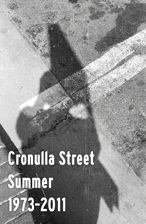User-generated images in space, time and place
Abstract
Years ago I came up with the idea of the Tourist Syndrome: I had observed tourists arriving on a bus at a scenic location, and spend their time taking photographs (with the viewfinder their window to the location), apparently at random, without thought to framing and subject. I'd imagined what it must be like for them reconstructing their visits and vicariously or virtually experiencing the actual place they had visited.
I thought of developing an exhibition based on the idea of replacing the actual experience of being somewhere, with photographs. The scenario would be: walk out of a bus at a significant site with the motor-drive running (I had the idea some time ago) and pointing the camera randomly all around. Walk around the scene, taking shots continually and without regard to the subject or framing. Later, in a darkened warehouse, hang (selected) prints in their correct relationship to each other so they can be viewed by walking along a fixed track that corresponds to the route taken by the original photographer.
What if you could gather photographs from people who visited a particular spot? On the same day? The same year? Over many years? What if you could gather all the photos taken by people with their phones and digital cameras of the World Trade Centre on 9/11? The London Tube Bombings? The Paris Riots?
Digital photography, the computer, photo sharing sites like Flickr and Panoramio, and geotagging of photographs now make it possible to access user generated images from the World Wide Web that represent a particular place or event.
In a program of practice-led research (two-thirds Studio Practice, one-third Dissertation), I propose to develop the techniques and processes necessary to harvest images from the Web, to locate these images accurately in time and space and display them online. I will show how these techniques can be used to develop an online exhibition of user generated photographs sourced from the Web of a particular event, like the Paris Riots. “Visitors” to the “gallery” would “wander” through the exhibition and experience the event through the images in two dimensions (with individual photographs and panoramas), three dimensions (where visitors can move from place to place and the perspective changes as if they were in the actual site the images were captured) and even over time as the event unfolds. In the Dissertation I will explore the history of sharing and use of user-created images; ethics and the ethical issues of using other people's images, legal issues (ownership, responsibility, reuse, sampling, and so on), and the havoc new technologies and distribution opportunities can wreak on traditional methods of access to images.
For further information see my Studio Practice proposal, Dissertation proposal, examples of geocoded photographs I have created myself, Reference material I have utilised to create this proposal, and some examples of my own photographs. I have also started a Journal for documenting the process.
A PhD proposal

James Steele PhD, MEd, BA is a researcher at the Australian National University and Professional Associate with the University of Canberra’s Inspire Centre for ICT Education. He was Project Manager for the Augmented Reality in Education research project funded by the Australian Government’s Office for Learning and Teaching, and now works on an Australian Research Council funded linkage project. Location-based Educational Services, with the ANU, UC, the National Portrait Gallery of Australia, Questacon and the National Capital Educational Tourism Project. He is the Director of Interactive Multimedia Pty Ltd, a consultancy, development and production company specialising in new media. James has been active in doing and teaching photography, web design, film, radio and video for over forty years in government, university, private industry and community media organisations. His recent projects include researching the use by academics of information and communication technologies in teaching and research for an Australian Learning and Teaching Council grant; streaming digital television throughout the world over next-generation IP networks; and producing video materials to highlight best practice in teaching mathematics and science. Until recently he was on the Board of Canberra’s music and arts radio ArtSound FM.
Dorrigo National Park from the Skywalk, 20 October 2007

An experimental installation for my graduate exhibition was held 10am – 5pm Tuesday 25 – Friday 28 September 2012 at the University of Canberra.
